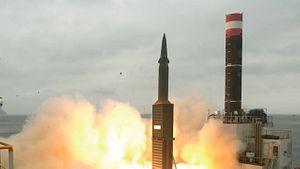In a September 4 telephone conversation, following North Korea’s sixth nuclear test, U.S. President Donald Trump and his South Korean counterpart, President Moon Jae-in, agreed to scrap warhead weight limits for South Korean ballistic missiles.
A White House readout of the call stated that both leaders pledged to strengthen joint military capabilities. “President Trump gave his in-principle approval to South Korea’s initiative to lift restrictions on their missile payload capabilities,” the statement reads.
“President Trump also provided his conceptual approval for the purchase of many billions of dollars’ worth of military weapons and equipment from the United States by South Korea,” the statement added.
As I reported last month, the South Korean request to develop more powerful ballistic missiles has been under consideration by the United States for a while. The U.S. Department of Defense is in the middle of reviewing the guidelines in consultation with the U.S. State Department to determine next steps.
“There is currently a limit on the warhead size and missiles that South Korea can have and yes, it is a topic under active consideration here,” a Pentagon spokersperson said last month. “I would tell you that we would be favorably inclined to do anything which furthers the defense capabilities of South Korea and we certainly have seen our alliance change and adapt over time before.” As I explained in August:
In a bilateral agreement signed in 1979, the United States and South Korea set out guidelines about the specific payload and range of the latter’s domestically developed missiles in order to avoid a regional arms race. These guidelines were updated in 2012. However, while South Korean missiles can have now an extended range of up to 800 kilometers (about 500 miles), the maximum payload remains unchanged at 500 kilograms (1,102 pounds).
The ROK military currently deploys two ballistic missiles, the Hyunmoo 2A and 2B both surface-to-surface missiles. The former has an estimated range of 300 kilometers, the latter can strike targets at a distance of over 500 kilometers. The 2A and 2B can both carry a warhead with a payload of up to 500 kilograms. There is also an extended range Hyunmoo 2 missile with an estimated range of 800 kilometers currently under development. The missile is expected to become operational by the end of 2017.
The 2C is an upgraded variant of the 2B also armed with a 500 kilogram payload. “The 2C, however, could be modified to accommodate a heavier warhead,” I noted last month. “Precision-guided ballistic missiles armed with a 1-ton warhead will likely have a bigger chance penetrating leadership bunkers and other underground facilities in the North.” South Korea’s ballistic missile arsenal is part of its deterrence strategy vis-à-vis North Korea.

































